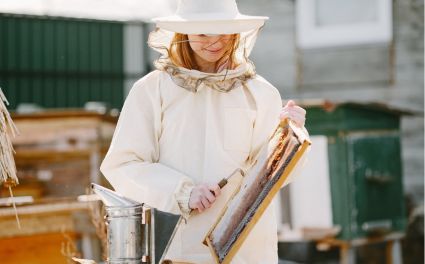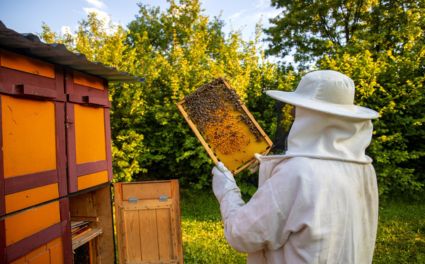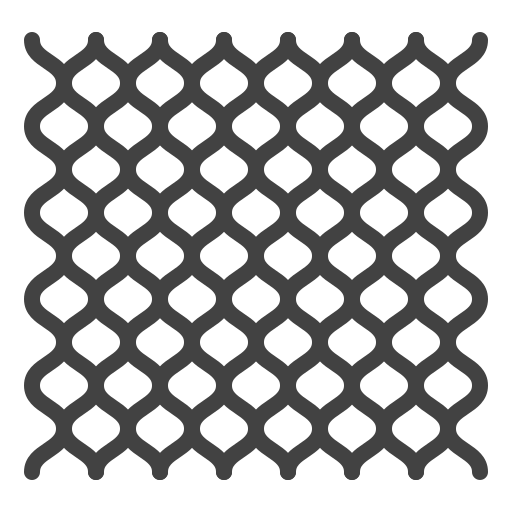Beekeeping is a fascinating and long-standing tradition that has been practiced for centuries. As the art of beekeeping grows in popularity, understanding the essential tools and protective gear becomes more important than ever. One of the most crucial aspects of beekeeping is the protective clothing that keeps beekeepers safe from stings. From beekeeping suits and beekeeping jackets to beekeeping gloves and beekeeping veils, every piece of equipment serves a vital purpose in ensuring the beekeeper’s comfort and safety.
However, many beginners often wonder — what do beekeepers actually wear, and how does this gear work? In this detailed guide, we’ll explore all the essential beekeeping equipment, from protective wear to useful tools that help maintain healthy hives. Whether you’re just starting out or already an experienced beekeeper, this guide will help you understand the function and importance of each item.
Beekeeping Supplies and Equipment
Beekeeping is rewarding but requires preparation and proper gear. The right beekeeping supplies ensure the safety of both bees and beekeepers, making every inspection and honey harvest efficient and safe.
Below is an overview of the most essential items every beekeeper should have.
Overview of Essential Beekeeping Supplies
-
Hive:
The hive serves as the bees’ home. It’s where they live, raise their young, and store honey and pollen. Properly maintained hives are crucial for a thriving colony. -
Frames:
Frames hold the bees’ honeycomb inside the hive and make it easier for beekeepers to inspect, manage, and harvest honey. -
Beekeeping Suits:
A full-body beekeeping suits provides the ultimate protection against stings. These suits are made from breathable fabrics like cotton or ventilated mesh, ensuring comfort and safety during hive inspections. -
Beekeeping Jackets:
Some beekeepers prefer beekeeping jackets instead of full suits. Jackets provide excellent upper-body protection while allowing more mobility, ideal for quick inspections. -
Beekeeping Gloves:
High-quality beekeeping gloves are essential to protect hands and wrists from stings. They’re usually made of soft leather or ventilated mesh for flexibility and comfort. -
Beekeeping Veils:
The face and neck are the most vulnerable areas when working with bees. Beekeeping veils protect these sensitive areas while allowing clear visibility and airflow. -
Beekeeping Trousers:
Some beekeepers use beekeeping trousers along with jackets for flexible coverage. They’re lightweight and made with elastic cuffs to prevent bees from entering. -
Beekeeping Ankle Protection:
Bees often crawl upward from the ground, so wearing beekeeping ankle protection or elastic cuffs over boots helps prevent stings near the legs and ankles. -
Beekeeping Smoker:
The smoker is an indispensable tool that calms bees by masking alarm pheromones, making hive inspections smoother and safer. -
Hive Tool:
A hive tool is a multipurpose instrument used to lift frames, scrape excess wax, and gently separate hive components.
Types of Beekeeping Equipment
Beyond the basic supplies, beekeepers use different equipment tailored to their experience level and hive setup.
Common Types of Beekeeping Gear
-
Beehives:
There are several hive types such as Langstroth, Warre, and Top-Bar hives, each with its unique structure and advantages. -
Honey Extractors:
These devices spin honey out of the comb without damaging it, allowing bees to reuse their wax foundation. -
Feeders:
Used to supplement bee diets when natural nectar is scarce, feeders are especially useful in colder months. -
Bee Brushes:
Gentle brushes used to move bees away from frames without harming them during inspections.
For beginners, starter kits that include protective gear, a smoker, hive tool, and a basic hive are ideal. Experienced beekeepers, however, often invest in advanced extractors, ventilated beekeeping suits, and higher-end protective clothing for professional use.

What Beekeepers Wear
While the tools are important, what beekeepers wear is what truly ensures their safety and peace of mind. Bees can become defensive, especially during honey harvesting, so protection is key.
Importance of Protective Clothing in Beekeeping
Bee stings can be painful and, for some individuals, even dangerous. Wearing protective clothing minimizes direct skin exposure and prevents bees from reacting to human pheromones or scents. The combination of beekeeping suits, jackets, veils, and gloves creates a reliable defense layer, making every inspection safer.
Components of a Beekeeper’s Outfit
-
Beekeeping Suit:
The cornerstone of protection, a beekeeping suit provides full coverage from head to ankle. It’s made from thick yet breathable fabric that prevents stings while allowing ventilation. -
Beekeeping Veil:
The veil protects the face and neck. It’s often attached to the suit or jacket with a zipper, forming a secure seal so no bees can get inside. -
Beekeeping Gloves:
Gloves cover hands and forearms, keeping them safe while allowing movement to handle frames and tools comfortably. -
Beekeeping Trousers and Jackets:
Some beekeepers prefer separate pieces like beekeeping jackets and trousers for flexibility, especially in hot weather. -
Beekeeping Ankle Protection:
Elastic cuffs or straps help seal gaps between trousers and boots to prevent bees from crawling upward. -
Beekeeping Kids Suits:
For young learners, beekeeping kids suits are specifically designed for safety and comfort, allowing children to learn beekeeping safely under supervision.
Alternatives to the Traditional Beekeeper Suit
Not every beekeeper wears a full suit. Some prefer lighter gear, such as half suits or beekeeping jackets over everyday clothing, especially for quick hive checks. These options still provide reliable protection while offering better airflow and ease of movement. The choice depends on climate, frequency of hive visits, and personal comfort preferences.
How a Beekeeping Suit Works
A beekeeping suit is more than just clothing—it’s engineered safety wear. It serves as a multi-layered barrier that keeps bees from making contact with skin. Here’s how it works:
-
The veil uses fine mesh that prevents stings while allowing visibility and ventilation.
-
The fabric (cotton, polycotton, or mesh) is thick enough to keep stingers from penetrating but light enough for airflow.
-
Elastic closures at wrists and ankles prevent bees from crawling inside.
-
Reinforced stitching adds durability and prevents tears, which can expose skin.
-
Ventilated suits allow air circulation, keeping beekeepers cool even in hot conditions.
The combination of these features ensures comfort, flexibility, and total protection during hive inspections.
Choosing the Right Protective Clothing
When selecting beekeeping gear, consider these factors:
-
Protection Level: Choose multi-layered suits or ventilated models for maximum safety.
-
Comfort and Breathability: Lightweight materials like mesh or cotton keep you cool.
-
Fit: Ensure a snug yet flexible fit for easy movement.
-
Durability: Reinforced knees, zippers, and seams prolong the life of your gear.
-
Visibility: Light colors reduce bee aggression and help keep you visible while working.
Combining protective wear like jackets, gloves, veils, trousers, and ankle protection ensures comprehensive safety while tending your hives.

Final Thoughts
Beekeeping is a fulfilling pursuit that requires both skill and the right protective gear. Every piece — from beekeeping suits and jackets to gloves and veils — plays a vital role in keeping beekeepers safe and confident while caring for their colonies.
Brands like OZ Armour are trusted globally for offering durable, high-quality protective wear designed to meet the needs of both beginners and professionals. Their products combine breathability, comfort, and full-body protection, helping beekeepers perform their tasks without fear of stings or discomfort.
Whether you’re managing a small backyard hive or a large apiary, investing in proper beekeeping equipments ensures safety, productivity, and peace of mind.
For beginners, consider exploring educational resources and quality gear collections to start your journey safely. Experienced beekeepers can upgrade their gear with ventilated suits and modern accessories for enhanced comfort.
To stay updated and informed, make sure to read more blogs about beekeeping for valuable insights, maintenance tips, and equipment recommendations.
👉 Visit OZ Armour to explore a wide range of reliable beekeeping jackets, suits, gloves, veils, trousers, kids suits, and ankle protection designed for every level of beekeeper.












